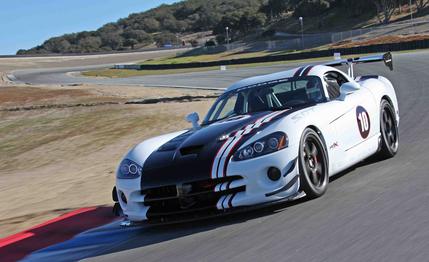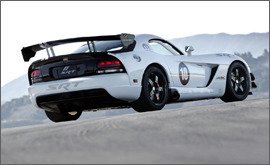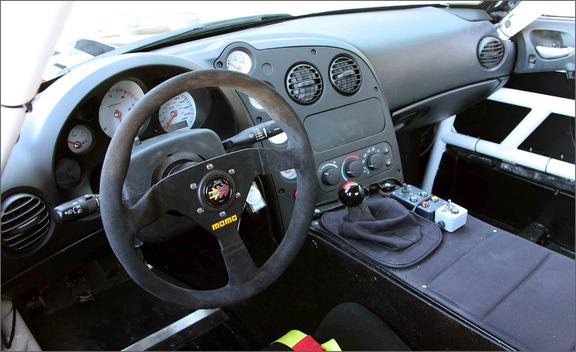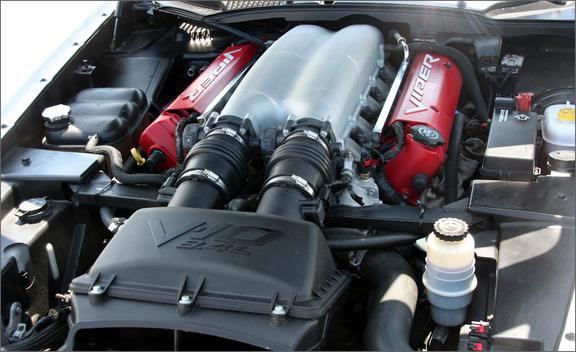 First Drive Review
First Drive Review
The Dodge Viper has been with us for nearly 20 years and will go out of production—at least for now—this summer. We’ve driven almost every variant of the car in that time, our reports often contributing to its reputation as a hairy-chested, have-your-affairs-in-order road weapon. Pity the fool who doesn’t respect 511 cubic inches of V-10 and rear-wheel drive without any electronic oversight save ABS.
In saying goodbye to the Viper, Chrysler invited us to GingerMan Raceway in South Haven, Michigan, for a turn in what will be one of the last iterations of the current car: the 2010 SRT10 ACR-X. Another street-legal, sticker-job special, you say, like the recent ACR Voodoo and 1.33 editions? No, the ACR-X is a proper fire-and-brimstone race car, devoid of the regulatory compromises that, er, water down lesser Vipers for street use.
Pumped Up and Stripped Out
A Viper race car is nothing new. The car has competed in pro-level racing since the mid-’90s and has graced the podiums of both Le Mans and Daytona. The top-rung Competition coupe currently battles in various GT classes around the world. But what sets the X apart is its more direct ties to the ACR street car and how clearly it demonstrates the potency of a civilian Viper configured solely for the track.
As with all 2010 Vipers, the X is powered by an 8.4-liter V-10 that spins the rear wheels via a six-speed manual gearbox. The X’s engine, however, has been uncorked by way of headers and a low-restriction exhaust system, which add 40 additional ponies for a total of 640. Torque is up 45 lb-ft to 605. The suspension is fully adjustable and sports higher spring rates that allow the chassis to maximize grip from the special 18-inch-front and 19-inch-rear Michelin slicks. Various aero tweaks, such as additional dive planes on the front fascia, provide up to 1100 pounds of downforce at 150 mph, or about 100 more than on the regular ACR.

Chrysler claims to have reduced the X’s curb weight by 120 pounds compared with the roadgoing ACR’s weight. The new total—about 3200 pounds—was mostly realized by thoroughly gutting the interior. The dash and the center console remain and an eight-point, SCCA-certified roll cage and fuel cell have been fitted, but the cabin is definitely sparse, with no side windows to roll down, a single racing seat and harness, and a removable Momo steering wheel. Other racing add-ons include a fire-suppression system, transmission and differential coolers, and larger front brake rotors fed by ducting that is more efficient than the street car’s.
The X’s improved power-to-weight ratio should be good for taking a 10th or two off the ACR’s 3.4-second 0-to-60-mph time and 11.8-second quarter-mile pass at 126 mph. The slicks will help the race car obliterate the street car’s 1.08 g of skidpad grip, but thanks to the extreme drag of all that downforce-generating aero, expect the top speed to stand fast at about 185 mph.

In Its Element
Chrysler wisely chose to warm us up to the new car by having us work through the Viper ranks on the track, from SRT10 roadster, to the ACR coupe, and then finally to the ACR-X. Although a racetrack is a controlled environment, these cars require your full respect and concentration. The ACR’s considerable downforce and Michelin Pilot Sport Cup tires plant you to the road and quell much of the nervousness of the base car, but it’s not until after you drive the X that you realize how much has been improved on.
Inside, you sit much lower than in the street car, and it feels much less cramped overall, particularly with the small, airbagless racing wheel offering a clear view of the gauges. The regular car’s slightly offset driving position is less noticeable, as well. Once the sticky Michelins get some heat in them and you get used to the raw, odd-firing bellow of the V-10, a transformation occurs as the car seemingly shrinks around you the harder you push it. Gone is the feeling of potential peril, replaced by the confidence that can only come from a set of grippy, race-spec gumballs. Sure, careless prods of the throttle will have you exiting corners tailfirst, but the chassis responds so quickly to inputs that you can catch all but the most serious twitches with little fuss.
Once comfortable enough to charge the car through corners, we were able to brake later, turn in harder, and power through kinks that we second-guessed in the ACR. Braking hard from speed feels as if it might damage internal organs, and with so much torque on hand—along with less weight and more grip—shifting was more of an option than a necessity. Even on the relatively tight GingerMan circuit, which has only a couple fast bends and moderate straights, the stability from the external aero appendages inspired great confidence, provided we had the courage to corner fast enough for them to work.
We, however, didn’t have the stones to push the ACR-X all the way to its screaming limits, which is why Dodge brought along Kuno Wittmer, an SCCA Pro Racing World Challenge driver who regularly runs a Viper Competition coupe. Being comfortable with racing Vipers and the speeds they’re capable of, he quickly humbled us with his pace. At the end of the day, Wittmer’s lap times around GingerMan’s 1.9-mile short configuration dropped to 1 minute 22.7 seconds in the ACR-X, some four seconds quicker than his time in the ACR.

Gentlemen, Start Your Engines!
Currently, only 25 examples of the ACR-X are scheduled to be built before the Viper’s Connor Avenue plant closes this summer (the vehicles go down the same line as other Vipers but are finished off at Roush Racing in Livonia, Michigan). All those cars are spoken for, but Dodge officials say an additional batch of 25 will be produced if demand is high enough. Being a race car, part of that demand depends on how well the racing action is received. Dodge and the Viper Racing League have organized the Dodge Viper Cup, a 10-event, spec-racing series for ACR-X owners. The series will visit several U.S. venues throughout the summer and fall. Cash will be awarded—$6500 for race wins, $25,000 for the championship. The cars will be eligible to compete in various other events sanctioned by the Viper Racing League, the SCCA, and NASA. Now, how about a guest media driver in one of the events so we can wrap up our impressions?
Fortunately, the price of entry into this club is not as significant as you might think and shows how much development has been put into the ACR street car. Whereas the ACR starts at $108,785, the ACR-X stickers at $110,000. The car is sold directly to owners sans warranty, but Dodge says it will offer an “attractively priced” package of spare parts for racing. Compared with the current Competition coupe, which costs closer to $200,000, that figure sounds like a bargain.
What’s Next?
What lies ahead for the next generation of Chrysler’s sports car is still a mystery, but we were assured that the company’s new Italian owners have enthusiastically embraced the Viper and support its continued development. Fiat CEO Sergio Marchionne is a devout motorhead, and the Italians have requested that several Vipers be shipped to the homeland for “study.” Electronic stability control will be reluctantly added due to new safety regulations, and a drop in overall weight is possible given concerns about fuel economy. But regardless of whether or not the next model is based on Maserati underpinnings or shares some engineering tech with Ferrari, as we’ve speculated in the past, we hope the company doesn’t file away all the car’s rough edges. It simply wouldn’t be a Viper if it didn’t have an attitude.